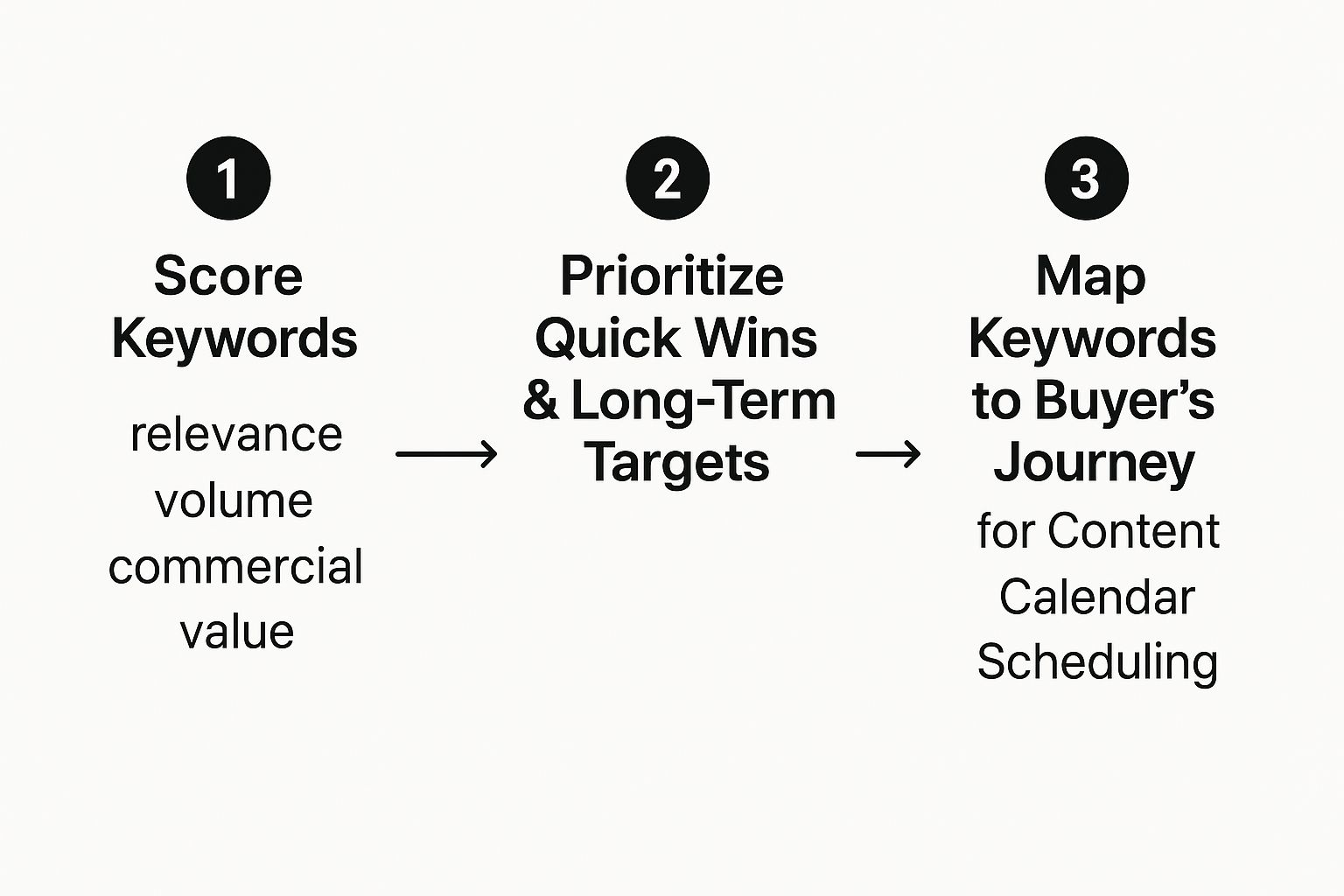Keyword research is the foundation of any successful SEO strategy. It’s not about guessing what people search for; it’s about using data to understand the exact words and phrases your ideal customers use to find solutions. This guide provides a practical, step-by-step process to uncover these valuable keywords and turn them into a content plan that drives traffic and growth.
Building Your Keyword Research Foundation

Before you open any SEO tool, the most critical work happens. Effective keyword research starts with empathy—understanding the real-world problems and questions your audience has. This foundational step ensures every keyword you target is relevant, purposeful, and aligned with your business goals.
Starting here prevents you from spending months creating content that no one is looking for. It roots your strategy in genuine human intent, not just abstract data points.
Get Inside Your Audience's Head
The first step isn't about keywords; it’s about people. Who are you trying to reach? What specific problems does your business solve? Answering these questions uncovers the why behind their search queries.
Actionable Insight: Create 2-3 detailed buyer personas. For a Kansas City-based roofer, a persona might be "David," a 45-year-old homeowner in Overland Park who just experienced a hail storm. His immediate problems are leak prevention and navigating insurance claims. This shifts your focus from broad terms like "roofer KC" to highly specific, actionable phrases.
David isn't just searching for a roofer; he's searching for solutions to urgent problems:
- "emergency roof tarping Kansas City"
- "how to file a roof damage insurance claim in Kansas"
- "best roofing companies for hail damage near me"
These aren't just search terms; they are direct expressions of a need. Your initial brainstorming should map out these core customer problems.
Uncover Your Initial Seed Keywords
With a clear picture of your audience's pain points, you can start brainstorming your seed keywords. These are the broad, foundational terms (1-2 words) that describe your primary services or products. They are the starting point from which your entire keyword list will grow.
Think about how you'd describe your business in a single breath. A local web design agency in Kansas City might start with seed keywords like:
- "web design"
- "SEO services"
- "e-commerce sites"
- "WordPress developer"
Practical Example: Your best seed keywords often come directly from customer conversations. Review your last 10 client emails or contact form submissions. If you're a plumber and see repeated mentions of "leaky faucet" and "water heater repair," those are your core seed keywords. They are a goldmine of authentic search terminology.
From these seeds, you can branch out to find more specific, long-tail variations. This list acts as the strategic backbone for your research, ensuring every keyword you find is tied to a business goal. This planning flows directly into your site's organization, which you can learn more about in our guide on how to plan your website structure.
Finding and Validating Your Core Keywords

With your seed keywords in hand, it's time to expand that list into a powerful arsenal of high-value search terms your customers are actively using. This part of the process is a blend of creative thinking and hard data.
We'll use a mix of free and paid tools to uncover what real people are typing into Google. The goal isn't just to find more keywords; it's to find the right ones—the phrases that signal genuine interest and perfectly match what you offer.
Uncover Keywords with Free Tools
You don't need an expensive software subscription to get started. Some of the most valuable insights come directly from the search engines themselves and the online communities where your customers gather.
Here are a few actionable methods:
- Google Autocomplete: Start typing a seed keyword into the Google search bar. The suggestions that appear are real, popular searches. Actionable Insight: Type your seed keyword followed by "for," "vs," or "near me." For a Kansas City web design agency, "kansas city web design for" might reveal gems like "kansas city web design for small business" or "kansas city web design for contractors."
- People Also Ask (PAA): This section in the search results is a goldmine for understanding user questions. A search for "best dog tags" might reveal PAA questions like "What are the most durable dog tags?" or "Are silicone dog tags better than metal?" Each question is a potential blog post or FAQ section.
- Community Forums: Search for your topics on Reddit, Quora, or industry-specific forums. Look at the exact language people use and the follow-up questions they ask. You'll find conversational, long-tail keywords that SEO tools often miss, like "Is a WordPress site too complicated for a small business owner to manage?"
Decoding Keyword Metrics That Matter
As you build your list, you'll encounter a few key metrics. Understanding them is critical for knowing where to focus your energy. Chasing high search volume is a classic mistake that leads to wasted effort.
The reality of search behavior is that the vast majority of keywords are highly specific and get low search volumes. Prioritizing terms with clear user intent, even with fewer searches, often yields much better results than competing for broad, high-volume keywords.
A great way to uncover what your rivals are ranking for is through a deep dive into their strategy. For a more detailed approach, check out our guide on how to conduct an SEO competitive keyword analysis. This process helps you spot opportunities they may have missed.
Here are the three most important metrics you need to focus on:
- Search Volume: The estimated number of monthly searches for a keyword. While a big number is tempting, remember that over 94% of all keywords get ten or fewer monthly searches. This stat, found in these SEO statistics on searchatlas.com, highlights the power of targeting many low-volume, highly specific "long-tail" keywords.
- Keyword Difficulty (KD): A score (usually 0-100) that estimates how hard it will be to rank on the first page of Google. Actionable Insight: If your website is new or has a low Domain Authority (under 30), focus almost exclusively on keywords with a KD score below 20. This is how you gain initial traction and build authority.
- Click-Through Rate (CTR): This metric predicts what percentage of people will click an organic search result. Some searches, like "what is the weather," get answered on the search page (a "zero-click search"), leading to a low CTR. Prioritize keywords where users need to click a link to get their answer, such as "how-to" guides, product comparisons, or service inquiries.
Using AI for Smarter Keyword Discovery
The old method of staring at endless spreadsheets is obsolete. The rise of AI has transformed keyword research from simple guesswork to deep, predictive analysis. It allows you to move faster and with greater accuracy.
Modern AI-powered tools provide a strategic edge by deciphering user intent, mapping topic relationships, and predicting search trends. This is how you build a sophisticated SEO strategy that outmaneuvers the competition.
Automate and Cluster for Efficiency
One of AI's biggest advantages is its ability to handle the most tedious parts of keyword research. Manually sorting thousands of keywords into logical topic clusters could take days. AI tools can do it in minutes.
Practical Example: You feed an AI platform a broad seed term like "Kansas City SEO." It instantly analyzes search results and generates logical clusters around subtopics. You'll get ready-made groups like:
- Local SEO Services: Keywords like "local seo agency kansas city," "google maps optimization kc."
- E-commerce SEO: Phrases such as "shopify seo kansas city," "e-commerce seo services kc."
- Cost and Pricing: Queries including "how much does seo cost in kansas city," "affordable seo kc."
This automation frees you to focus on strategy and content creation instead of getting bogged down in manual data sorting.
AI doesn't just find a list of keywords; it reveals the entire underlying structure of a topic. This allows you to build out comprehensive content hubs that scream authority and help you dominate the search rankings for your niche.
This screenshot from Semrush's Topic Research tool perfectly illustrates this. It shows how AI can generate a web of related subtopics and questions from a single core idea.
The tool visualizes content ideas, letting you see at a glance what questions your audience is asking and which headlines are already performing well.
Uncovering Hidden Long-Tail Keywords
This is where AI truly excels. It has an incredible ability to uncover valuable long-tail keywords that traditional methods often miss. These are the specific, multi-word phrases that signal high user intent and have much lower competition.
Long-tail keywords are a massive opportunity, making up around 70% of all search traffic.
The evolution of keyword research is a significant market trend. By 2025, the global AI market is projected to exceed $190 billion, with a large portion driven by AI's application in digital marketing. These tools process millions of search queries to find the patterns that lead to conversions. You can get more insights on 2025 AI keyword research trends on superagi.com.
Once you've uncovered these valuable keywords, the next step is implementation and measurement. Learn how to track your website traffic to see the real-world impact of your new keyword strategy.
Turning Your Keyword List Into a Content Plan
A raw keyword list is just data. The real magic happens when you transform that spreadsheet into a strategic content plan that guides your marketing and achieves measurable results. This is the bridge between knowing what people search for and creating the content that meets their needs.
Score and Prioritize Your Keywords
Trying to target every keyword is a recipe for burnout. You need a simple system to separate quick wins from long-term goals. A scoring method can bring instant clarity.
Actionable Insight: Create a simple spreadsheet and score keywords from 1-5 on three criteria. This exercise will immediately reveal your top opportunities.
- Relevance (Score 1-5): How closely does this keyword align with a core product or service you sell? (5 = direct match).
- Opportunity (Score 1-5): Is the search volume realistic and the keyword difficulty low enough for you to rank? (5 = sweet spot of decent volume and low KD).
- Commercial Intent (Score 1-5): Does the keyword signal someone is ready to buy? Terms with "buy," "services," "quote," or "near me" score a 5.
Add up the scores. The keywords with the highest totals (12-15) are your top priorities. These are the terms most likely to drive meaningful traffic and conversions.
This infographic lays out a simple workflow for this process, taking you from initial scoring and prioritizing right through to mapping keywords for your content calendar.

Following a workflow like this ensures every piece of content you create is backed by data and directly supports your business goals.
Build Authority with Topic Clusters
Once you have your high-priority keywords, organize them using the topic cluster model. This powerful SEO strategy involves creating a central "pillar" page on a broad topic, then surrounding it with multiple "cluster" articles that dive deep into related, specific subtopics.
Practical Example: A Kansas City marketing agency's pillar page is "The Ultimate Guide to Small Business SEO." The cluster content would be individual blog posts targeting long-tail keywords like:
- "how to set up Google Business Profile"
- "local SEO tips for plumbers in KC"
- "measuring content marketing ROI"
Each cluster post links back to the main pillar page. This structure signals to search engines that you are an authority on the topic, helping you rank for a wide range of related keywords. This is a core part of building a successful plan, which you can learn more about in our guide on how to create a content strategy.
The goal of the topic cluster model is to create a tightly-knit web of content that comprehensively covers a subject. This approach not only improves your SEO but also provides immense value to readers by making it easy for them to find related information.
Ultimately, ranking high is what drives results. As of 2025, an incredible 70% of all clicks on Google's search results go to the first five organic listings. And 75% of users never even scroll past that first page.
These numbers make it crystal clear: a well-planned keyword strategy isn't just a nice-to-have. It's essential for capturing any valuable traffic at all.
Weaving Keywords into High-Ranking Content
This is where your research meets the blank page. Having a great keyword list is one thing; weaving those terms into compelling, high-ranking content is another. The goal is to write for humans first, while still sending clear signals to search engines.
The days of keyword stuffing—awkwardly jamming a phrase into a paragraph repeatedly—are long gone. Modern search algorithms reward content that covers a topic comprehensively and satisfies user intent.
Strategic Keyword Placement
While you should never force keywords, there are high-impact locations where placing your primary keyword makes a significant difference. These are signposts that help Google instantly understand your page's topic.
Here are the most critical placements:
- Title Tag: The clickable blue link in search results. This is one of the most powerful on-page SEO factors.
- H1 Heading: The main title on the page. It must be clear, engaging, and contain your primary keyword.
- First 100 Words: Introduce your main topic and keyword early to confirm relevance for both readers and search engine crawlers.
- URL: A clean, readable URL including the keyword (e.g.,
yoursite.com/how-to-conduct-keyword-research) is a best practice.
Another crucial spot is your meta description. While not a direct ranking factor, a well-written meta description that includes your keyword can dramatically boost your click-through rate. For a deeper dive, learn more in our guide on how to write compelling meta descriptions.
Building Topical Authority with Semantic Keywords
To truly dominate search results, you must think beyond a single primary keyword. Modern SEO is about building topical authority—proving to Google that you're an expert by covering a subject from every angle using a rich vocabulary of related terms.
This is where semantic keywords come in. These are the related concepts, synonyms, and subtopics that naturally appear in a conversation about your main topic.
Actionable Insight: For a post on "how to conduct keyword research," semantic terms would include:
- long-tail keywords
- search intent
- keyword difficulty
- SEO tools
- topic clusters
- user query analysis
- content strategy
Using a rich variety of semantic and LSI (Latent Semantic Indexing) keywords helps Google understand the context and depth of your content. This allows you to rank for hundreds of related search queries, not just your single target phrase.
For example, instead of repeating "keyword research" ten times, naturally use phrases like "analyzing search terms," "finding user queries," or "validating keyword ideas." This creates a more natural, authoritative, and helpful piece of content. It’s the difference between a page that is simply about a topic and a page that is a true resource.
Got Questions About Keyword Research? We've Got Answers
Even with a solid plan, questions are bound to pop up. Getting these details right can elevate your strategy from good to great, leading to better, faster results. Here are answers to the most common questions we hear.
How Often Should I Do Keyword Research?
Keyword research should be an ongoing habit, not a one-time project. Conduct a major, deep-dive strategy review annually, but be more agile month-to-month.
Actionable Insight:
- Project-Based: Perform focused research for every new piece of content, product launch, or marketing campaign.
- Monthly Review: Spend 30 minutes each month reviewing your keyword rankings in Google Search Console. Look for "low-hanging fruit"—keywords where you rank on page 2 (positions 11-20). A few on-page optimizations can often push these to page 1 for a quick traffic boost.
What Is the Difference Between Short-Tail and Long-Tail Keywords?
This is a fundamental concept that directly impacts your strategy's effectiveness. The difference is specificity and user intent.
- Short-Tail Keywords: Broad, 1-2 word terms like "SEO services." They have high search volume but are extremely competitive, and the user's intent is vague.
- Long-Tail Keywords: Specific, 3+ word phrases like "local SEO services for plumbers in Kansas City." The volume is lower, but competition is minimal, and the intent is crystal clear, leading to much higher conversion rates.
A new business will see faster results by focusing on a portfolio of low-competition, high-intent long-tail keywords rather than trying to compete for a single, high-volume short-tail term.
Can I Rank Without Using the Exact Keyword Phrase?
Yes, absolutely. Modern search engines like Google use advanced AI to understand context, synonyms, and the overall topic of a page. Google is far more interested in whether your content provides a comprehensive answer to a user's problem than whether you've repeated an exact phrase five times.
This is the core idea behind semantic SEO. Your goal should be to cover a topic in-depth, using related terms and answering adjacent questions a user might have. This approach will naturally help you rank for hundreds of keyword variations, many of which you never targeted directly.
Ready to turn your keyword research into a high-ranking website that drives real business growth? The experts at Website Services-Kansas City specialize in creating SEO-optimized WordPress sites for businesses just like yours. Learn more about our professional website development and SEO solutions.